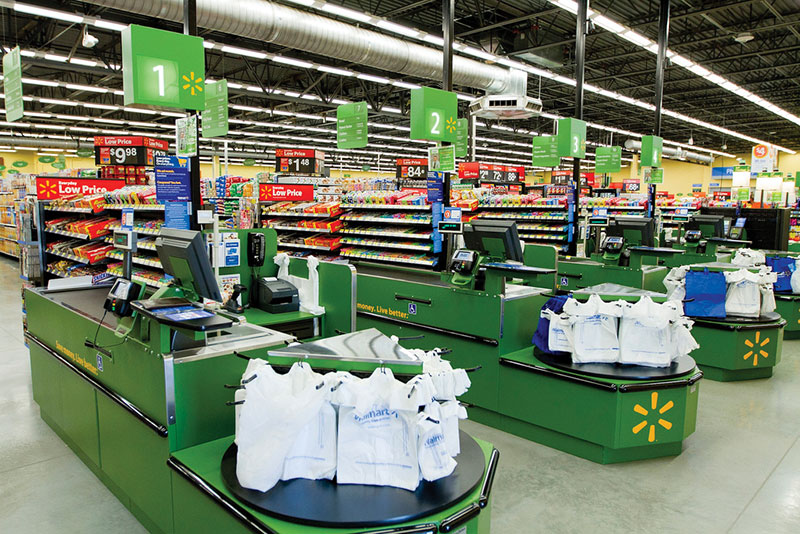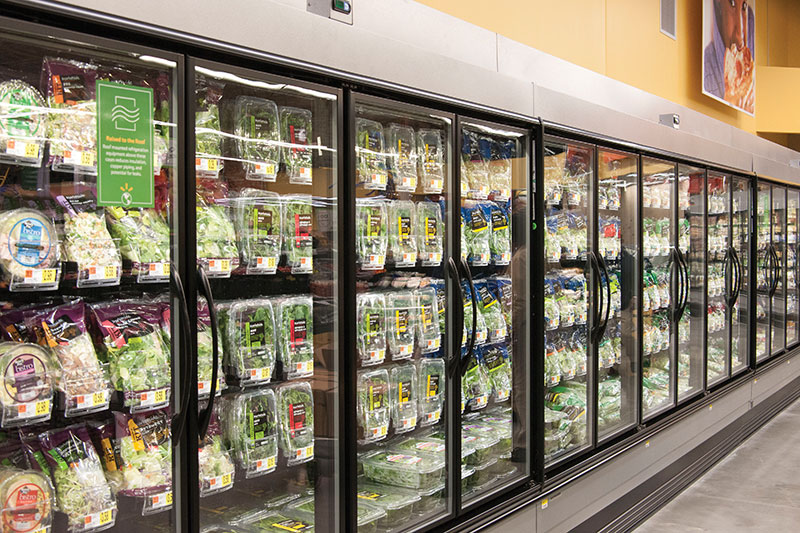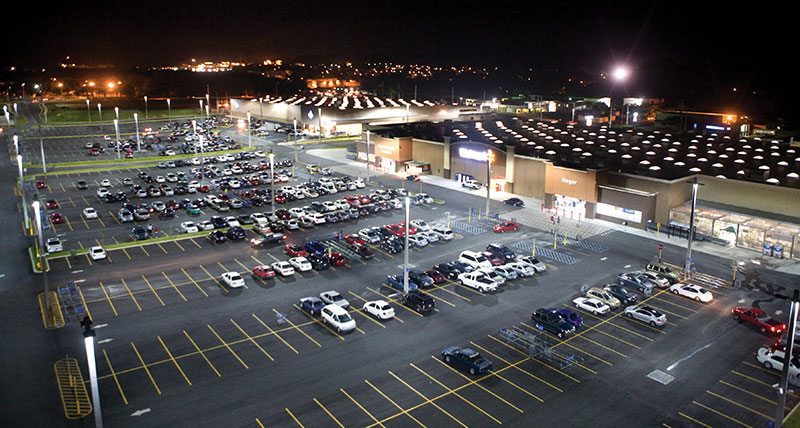Walmart leads the retail industry in LED lighting applications, teaming up with GE Lighting to achieve a 40% reduction in store lighting costs worldwide.
BY KATIE LEE
When Walmart makes a change, people take notice. If you’re as big as Walmart, and you choose to adopt LED signage or new LED freezer case lighting or LED parking lot lighting, you will get people’s attention. It goes without saying, then, that widespread rollouts of such technology can literally transform an entire industry.
For more than a decade, Walmart and vendor partner GE Lighting have been busy making waves by pioneering the use of new lighting technologies in the commercial retail space. According to GE, Walmart was one of the first leaders to leverage GE LED signage and then quickly adopted GE LEDs in refrigerated display cases and parking lot fixtures. Today, the mega retailer has turned its focus to sales floor lighting with the ultimate goal being to reduce store lighting costs by 40% worldwide.
 Guess what? That goal is being realized. With energy being Walmart’s second highest operating cost, what a difference 40% makes when you have 11,462 stores across the globe. This is how a giant corporation makes waves. The ripple effects from its sustainability efforts can affect not only the retail industry but the planet itself.
Guess what? That goal is being realized. With energy being Walmart’s second highest operating cost, what a difference 40% makes when you have 11,462 stores across the globe. This is how a giant corporation makes waves. The ripple effects from its sustainability efforts can affect not only the retail industry but the planet itself.
According to GE, both GE and Walmart have remained committed to bringing energy-efficient solutions to stores, inside and out. “Seeing the energy- and cost-saving benefits of more efficient technology allowed Walmart to become an early adopter of commercial LED applications, and it has helped GE to develop more intelligent solutions,” says Melissa Wesorick, GE lighting product leader.
It all began in 2003. According to Charles Zimmerman, vice president of international design and construction, Walmart needed a better solution for its signage lighting and GE asked, “Have you ever heard of LED?” At the time, Zimmerman recalls, red LEDs were about the only option that made sense. Once Walmart began seeing the benefits of the new red bulbs — their long life; their tolerance of cold, wet weather; their use of very little energy — the company started pressing GE to get more colors, specifically white.
“From that point on, we were always asking what’s next,” says Zimmerman. “GE could basically use us as their laboratory.”
 Next up for Walmart were freezer cases. In 2005, Walmart worked with GE to develop a specific LED strip — now on Generation 7 or 8 — to use in grocery freezer cases. “Back in 2005, we had the product in some experimental stores,” Zimmerman recalls. “I remember being at the GE offices talking about cool it would be someday when we could go in virtually any competitor’s store around the world or any mom-and-pop store and see that product. Within about 4 or 5 years, that was reality. I travel around the world, and 95% of the leading grocery stores I visit now have LEDs in their freezer cases. And in many cases, it’s the LED strip that we developed hand in hand with GE back in 2005.”
Next up for Walmart were freezer cases. In 2005, Walmart worked with GE to develop a specific LED strip — now on Generation 7 or 8 — to use in grocery freezer cases. “Back in 2005, we had the product in some experimental stores,” Zimmerman recalls. “I remember being at the GE offices talking about cool it would be someday when we could go in virtually any competitor’s store around the world or any mom-and-pop store and see that product. Within about 4 or 5 years, that was reality. I travel around the world, and 95% of the leading grocery stores I visit now have LEDs in their freezer cases. And in many cases, it’s the LED strip that we developed hand in hand with GE back in 2005.”
Back then, in 2005, Walmart also had the foresight to make a commitment to share everything it learned with other retailers, including its competition. “We would actually take our competitors into these stores and show them the LED installation, explain why we were doing it, explain the benefits, introduce them to our vendors, share the plan and specs,” says Zimmerman. “Then the lightbulb goes off — pardon the pun — and they take it from there.”
Not all retailers could see past the higher initial price point for LEDs, however. “Fortunately our leadership has been visionary enough, and intelligent enough, not to make short term decisions and giving us the latitude to, when it makes economic sense, prove the payback,” says Zimmerman. “I think a lot of them are still hung up on that first cost, but the problem is, we’ve changed the industry standards. That’s not a problem — it’s a great thing. We buy more lighting than anyone in the world; we buy more refrigerated cases than anyone in the world. So if somebody were to go to a refrigeration manufacturer today and say, ‘You know, I don’t want LED lighting — I want fluorescent.’ I’m not sure they could even order it! We did that with signage, with parking lot lighting, with freezer case lighting and now, with sales floor lighting, we’re changing the industry yet again.”
Adds GE’s Wesorick: “Commercial LEDs are becoming the go-to solution for retailers, as technology improves and becomes more affordable,” she says. “Retailers are seeing other success stories in the industry and want to achieve the same improvements. We expect the LED momentum to continue, especially as we can continue to invest in technology and solutions that create an intelligent environment.”
Zimmerman says GE Lighting originally estimated the year 2020 for Walmart’s sales floor lighting conversion to LED, but here it is 5 years earlier. “Even they sorely underestimated how rapidly this technology would take off,” he says.
And take off it has — at least outside the United States. With very low utility rates compared to foreign countries and little to no government subsidies, there is less monetary motivation in the U.S. to convert to LED. Walmart’s international stores, however, have jumped on the LED train quickly. Not just with new store construction but retrofits as well.
“Japan is retrofitted nearly 100%, and China has retrofitted a very high percentage of their stores,” says Zimmerman. “I don’t think the U.S. has actually done any retrofits yet. The economics for retrofits are harder because we already have a very efficient system in place [such as daylight harvesting]. To spend the money to tear out that system and replace it is a little tougher nut to crack. The U.S. could be the last domino to fall out of all of our markets.”
He adds: “Fortunately, on new stores, that domino fell last year.”
In October 2013, Walmart opened its first 100% all-LED supercenter in the United States. (No matter that China and Japan beat this store opening by more than 2 years in their respective countries — this is a big deal for the U.S.) Located in South Euclid, Ohio, the pilot program allowed Walmart to gauge the quality and efficiency of the lights and determine the return on investment with LEDs. Among the variety of GE lights used in the store are the LuminationTM IS Series Luminaires, featured in the ceiling application. According to Walmart, main sales floor lighting represents approximately 90% of the total lighting usage in each building; therefore, this implementation will reduce energy use per store by more than 5% in the U.S. alone. The lights have a longer life span than traditional lighting fixtures and also offer significant savings in maintenance costs.
“All lighting in the South Euclid Walmart store, with the exception of emergency lighting and heated cases, is made up exclusively of LED technology,” says Wesorick. “The LED fixtures used throughout the property [see sidebar] were designed at GE Lighting’s headquarters in nearby East Cleveland, and GE hopes to help Walmart fully outfit other stores in this capacity.”
The move to LED ceiling lighting in the U.S. — Walmart’s largest purchase of LED lighting to date — is expected to produce an energy savings of 340,000 kilowatt hours per store, equating to more than $34,000 in savings per year in each store. Two hundred new Walmart stores will be adopting the new GE LED ceiling lighting over the next 2 years. According to Wesorick, through 2016, some stores will also adopt outdoor and refrigeration LED lighting for additional energy and cost savings.
“The U.S. fleet represented an opportunity working with GE to develop a product that we could then roll out to all of our other markets,” says Zimmerman. “Many of our markets are using that exact same fixture that you see in Euclid, Ohio. That light fixture could hang in schools, hospitals, basically any type facility anywhere in the world. As big as Walmart is, the things we’re developing working with partners like GE go way beyond the retail footprint.”
Corporately, Walmart has a 2020 Energy Efficiency Goal stating the company will increase its energy efficiency by 20% by 2020, using the 2010 baseline. “And I can proudly tell you, in international we’re already at 17% toward that goal,” says Zimmerman. “A big part of it is our LED ramp up.” In addition to LED, Walmart is achieving its 2020 goals by leveraging numerous models of renewable energy sources: wind, solar, hydro and biogas.
What a difference a decade makes. “For practically 100 years, lighting didn’t really change much,” notes Zimmerman. “It got slightly more efficient, but incandescent bulbs and fluorescent bulbs have been around literally for 100 years. Then from 2003 to 2013, more change occurred in the lighting industry in those 10 years than it occurred in the previous 100.”
Riding the forefront of that wave of change have been Walmart and GE Lighting: great partners from the past building and reshaping an even greater future for sustainable, energy-efficient, environmentally responsible lighting — for the retail industry and beyond.
SIDEBAR:
LIGHTING UP WALMART WITH 100% LEDs
LED lighting in the South Euclid, Ohio, supercenter includes:
• Ceiling: GE’s Lumination™ LED lighting fixtures are installed in the ceiling, delivering visually appealing light and minimal glare to Walmart’s sales floor. Featuring stylish, modern designs, the new LED ceiling lighting produces an even glow that provides uniform light to fill the desired space. With a life rating of 50,000 to 65,000 hours, the Lumination fixtures deliver exceptional energy efficiency and maintenance savings.
 • Outdoor: In the parking lot, Walmart met a wide range of lighting needs by utilizing GE’s Evolve™ LED Area Lights. The area lights include the Evolve LED Area Light Wall Pack & Egress, which offer a modern “wedge” look and feature GE’s exclusive optical ring designed to effectively direct the light and produce superior vertical illuminance when mounted on exterior walls. In addition, dimmable controllers help Walmart maximize energy savings.
• Outdoor: In the parking lot, Walmart met a wide range of lighting needs by utilizing GE’s Evolve™ LED Area Lights. The area lights include the Evolve LED Area Light Wall Pack & Egress, which offer a modern “wedge” look and feature GE’s exclusive optical ring designed to effectively direct the light and produce superior vertical illuminance when mounted on exterior walls. In addition, dimmable controllers help Walmart maximize energy savings.
• Refrigeration: GE’s Immersion™ RV40 and Immersion™ RH20 LED lighting systems are used in Walmart’s frozen food and medium temperature refrigerated display cases. They lower maintenance and energy costs while enhancing the visual appeal of both vertical and horizontal cases.
— Melissa Wesorick, GE Lighting Product Leader
— Email the editor at [email protected]. This article originally appeared on the cover of the April/May 2015 issue of Retail Facility Business magazine.
